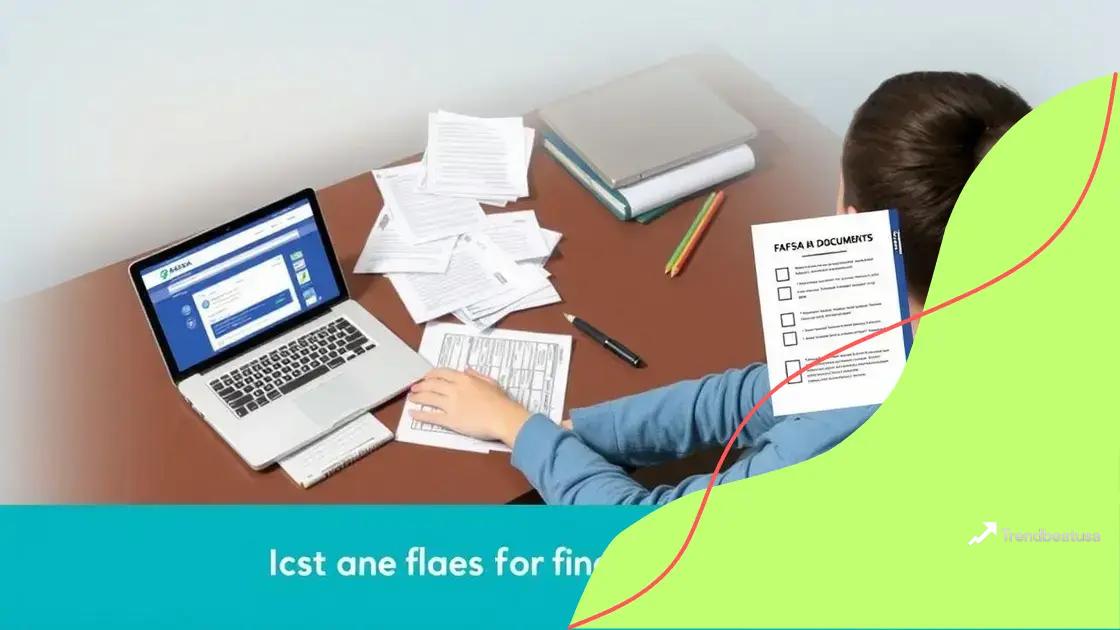College affordability programs expanded: What you need to know

College affordability programs are initiatives designed to reduce the cost of education through financial aid, grants, and scholarships, making higher education accessible to more students.
College affordability programs expanded are making it easier for students to pursue their dreams without breaking the bank. Have you wondered how these initiatives can impact your educational journey? In this article, we’ll delve into the details and opportunities these programs offer.
Understanding college affordability programs
Understanding college affordability programs can be crucial for students looking to ease their financial burden. These programs aim to reduce the cost of education, helping individuals achieve their academic goals without overwhelming debt.
Many students are unaware of the assistance available to them. Programs like federal grants, scholarships, and work-study opportunities can significantly lessen tuition fees and associated educational expenses.
Types of College Affordability Programs
Here are some common types of programs that can help make college more affordable:
- Federal and state grants
- Scholarships based on merit or need
- Income-driven repayment plans for loans
- Work-study programs offering part-time work
Each of these options serves a purpose. Federal grants, for example, don’t need to be repaid and are often awarded based on financial need. On the other hand, scholarships can be earned through academic achievement, community service, or other criteria.
Applying for Financial Aid
Filing the FAFSA (Free Application for Federal Student Aid) is an essential step in applying for various funding sources. It opens the door to numerous types of financial aid. However, many students hesitate to apply, fearing ineligibility. In reality, most students qualify for some form of aid.
The process can be straightforward. Gather necessary documents, such as tax returns and other financial data, to complete the application accurately. It’s also wise to check college deadlines to ensure timely submission.
Once accepted into a college, it’s important to regularly review financial aid options. As circumstances change, so may eligibility for various programs. Staying informed on updates can lead to additional funding opportunities.
Real-Life Impacts
Many students have shared how affordability programs changed their educational journeys. A single scholarship can transform a college experience, allowing students to focus on academics rather than financial struggles. Countless graduates can credit their success to the support they received through these programs.
In conclusion, understanding college affordability programs is vital for prospective students. By taking advantage of available resources, students can alleviate financial stress and fully immerse themselves in their college experience.
Key benefits of expanded programs
Exploring the key benefits of expanded programs is essential for understanding how they can help students achieve their educational goals. These programs offer more than just financial aid; they create pathways for success.
One of the most significant advantages is the increased access to education. Expanded programs often provide more funding options, which means that even more students can afford to attend college. This helps to level the playing field and allow diverse populations to benefit from higher education.
Financial Relief
Expanded college affordability programs can lead to significant financial relief for students and their families. This relief can manifest in several ways, including:
- Reduced tuition costs, making college more attainable.
- Greater availability of grants and scholarships that do not require repayment.
- Flexible loan options that consider students’ financial circumstances.
- Work-study opportunities that help students gain experience while earning money.
These financial considerations are crucial, especially for low-income families who might struggle to pay for college. By easing the financial burden, students can focus more on their studies.
Support Systems
Another benefit of expanded programs is the creation of robust support systems. Many programs include counseling services, mentoring, and academic resources, assisting students in navigating their educational journeys.
For example, some programs offer free tutoring services or workshops aimed at improving study skills. This support not only enhances academic performance but also boosts students’ confidence, making them more likely to succeed.
Moreover, students can often connect with peers who share similar struggles and ambitions, fostering a sense of community and belonging. This emotional support can be vital in overcoming challenges during college life.
In summary, the key benefits of expanded programs extend beyond financial assistance. By increasing access, providing financial relief, and enhancing support systems, these programs play a pivotal role in shaping a brighter future for countless students.
How to apply for financial aid

Learning how to apply for financial aid is a vital step for any student seeking assistance to afford college. The process can seem overwhelming, but with the right information, it becomes manageable.
The first step is to complete the FAFSA, which is the Free Application for Federal Student Aid. This form determines your eligibility for various types of financial aid, including grants, scholarships, and loans. It’s important to gather necessary documents before you start, such as your Social Security number, tax returns, and bank statements, to ensure accurate and complete information.
Gather Required Documents
To avoid delays, be prepared with the following:
- Social Security number or Alien Registration number
- Federal tax information and bank statements
- Records of untaxed income
- A list of schools you are interested in attending
These documents will not only help you fill out the FAFSA accurately but also provide valuable information for schools that may offer financial assistance.
Completing the FAFSA
Once you have your documents ready, visit the official FAFSA website. It’s crucial to fill out the form carefully. Make sure to enter your information correctly, as errors can lead to delays in processing. After filling out the form, submit it electronically for quicker processing.
Keep in mind that each state and college may have different deadlines for applying. Check these dates to make sure you submit your FAFSA on time. Some states even have limited funds, so applying early could increase your aid chances.
After submission, you will receive a Student Aid Report (SAR), summarizing the information you provided. Review this carefully to ensure there are no mistakes. If everything looks good, your SAR will be sent to the colleges you listed.
Aid Offers
After schools receive your SAR, they will prepare financial aid offers based on your eligibility. This will typically include details about scholarships, grants, loans, and work-study opportunities. Compare the offers from different colleges to understand what support each institution provides.
In summary, understanding how to apply for financial aid can open doors for many students. Being organized and informed can set you on the path to successfully funding your education.
Real-life success stories
Real-life success stories highlight the impact of college affordability programs on students from various backgrounds. These stories show how financial aid can change lives and open doors to education.
Take the case of Maria, who grew up in a low-income neighborhood. She almost gave up on college due to high costs. However, after learning about scholarship opportunities, she applied and received funding that covered her tuition. This support allowed her to focus on her studies and graduate with honors, paving the way for a successful career in engineering.
Community Support
Many success stories are also shaped by community support. For instance, James participated in a work-study program that connected him with local businesses. Through this program, he gained valuable experience while earning money for school. This network helped him secure a full-time job after graduation.
Additionally, initiatives like mentorship programs have helped students navigate their academic paths more effectively. For example, Linda was paired with a mentor who guided her through the financial aid process, ensuring she maximized her resources. With this guidance, she landed a scholarship that significantly reduced her debt.
Overcoming Challenges
Many students face challenges, but the support from affordability programs strengthens their resolve. Alex, for example, dealt with personal hardships while studying. He utilized counseling services offered through his college’s financial aid office, which made a difference in his ability to stay focused on his education.
These real-life experiences demonstrate that college affordability programs are not just financial tools; they are life-changing pathways. By sharing success stories, we can inspire future students to take advantage of these resources, knowing that they too have the potential to succeed in their academic pursuits.
Future of college affordability initiatives
The future of college affordability initiatives looks promising as more institutions recognize the importance of accessible education. This shift is driven by the need to reduce student debt and encourage higher enrollment rates among underserved communities.
One major trend is the increase in state funding for higher education. Many states are implementing programs designed to provide free community college or significant tuition reductions for in-state students. This support can pave the way for greater access to education for all.
Innovative Payment Models
As educational costs rise, new payment models are emerging. Income-driven repayment plans are becoming more common. This approach allows graduates to pay a percentage of their income rather than a fixed amount. This flexibility makes it easier for individuals to manage their debt while contributing to the economy.
Additionally, colleges are experimenting with cost-sharing models, where students contribute financially only when they benefit from a program. These initiatives keep students engaged and lessen financial burdens during their studies.
Increased Collaboration
The future of college affordability will also see more collaboration between colleges, businesses, and government entities. Partnerships can lead to internship opportunities, scholarships, and mentoring that are essential for student success. For instance, businesses may offer scholarships tied to job placements after graduation, ensuring that students directly benefit from their educational investment.
Furthermore, community organizations are stepping up to support affordable education initiatives. They provide resources and guidance to help students navigate the financial aid process. This support enhances a student’s ability to secure funding and understand their options.
In summary, the landscape of college affordability initiatives is evolving. With innovative payment models, increased collaboration, and greater institutional support, the path to accessing higher education is becoming clearer. These advancements will empower more students to pursue their academic dreams.
FAQ – Frequently Asked Questions about College Affordability Programs
What are college affordability programs?
College affordability programs are initiatives designed to make higher education more accessible and less expensive for students through financial aid, grants, and scholarships.
How can I apply for financial aid?
To apply for financial aid, you need to complete the FAFSA (Free Application for Federal Student Aid) and submit it along with required documents to your chosen institutions.
What types of financial aid are available?
There are several types of financial aid available, including federal and state grants, scholarships, work-study programs, and student loans.
How do community organizations support college affordability?
Community organizations often provide resources, guidance, and financial assistance to help students navigate the financial aid process and access funding options.
